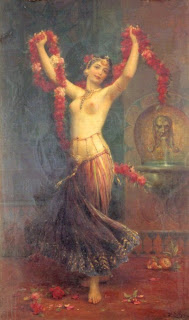As featured on Racialicious.
It’s time to set the record straight, everyone. So here it is: belly dancing is not a significant facet of Middle Eastern culture. It’s a dance, not a lifestyle (not according to most Middle Eastern people, anyway).
I’ve had one too many people ask me if I belly dance when they hear about my religion or ethnicity. Belly dancing is something that is present in some form of another in most Middle Eastern cultures, but is not really a part of our identity. And I assure you, nowhere in the Holy Qur’an does it say, “Thou shalt belly dance.” But because of Hollywood’s old Orientalist glamour, images of belly dancing have become almost synonymous with the Middle East.
I can’t help but get irritated when someone assumes that s/he and I automatically have something in common because s/he belly dances. The truth of a real-live Middle Eastern woman belly dancing seems to validate all those silly images that come into one’s head about spangly costumes and the Dance of the Seven Veils. Belly dancing has a host of sexualized and savage images attached to it, and if Middle Eastern/Muslim women confess to belly dancing (for exercise, as a career, for fun, or whatever), those images get attached to us, and we no longer have individual thoughts or lifestyles. We don’t take care of our parents or our children, we don’t have jobs or have opinions about health care reform, we just belly dance. Like it’s all we do, all day. This is why it’s insulting when someone thinks s/he knows what it’s like to be a Middle Eastern/Muslim woman because s/he’s taken a belly dancing class or read a book about it. The image of a Middle Eastern woman belly dancing seems to take away from our identity: it erases who we really are, our different nationalities and ethnicities, our emotions, our day-to-day existence.
Now, let me assure you: my problem isn’t with the dance itself. Belly dancing is a great way to connect with one’s sensuality, to exercise, and to appreciate the body that God gave you. Nor is my problem with non-Middle Eastern women (or men) belly dancing (or with Middle Eastern people dancing).
What bothers me is the adoption of a caricatured Middle Eastern identity through coin-bedazzled bras and Middle Eastern stage names like “Amina” or “Vashti.” If you’re a non-Middle Eastern performer, why give yourself a Middle Eastern stage name? What’s wrong with a name that reflects your own ethnicity or interests? Is it not “ethnic” or “exotic” enough? Besides, how would you feel if someone else used the name your parents gave you (that perhaps also belonged to your grandmother or aunt) as a stage name for an act that most people in your culture consider shameful if done publicly? (Cultural lesson: in most parts of the Middle East, belly dancing is often a cover for illicit activities.)
Similarly, dance troupe names like “Desert Queens” or “Daughters of Scheherazade” serve the same exoticizing purpose when these troupes are full of non-Middle Eastern women set in a non-Middle Eastern setting (like Austin, Texas, for example, which hosted a Belly Dancing Convention last July).
I take offense at the presentation of Middle Eastern “culture” through things like transparent veils, coin necklaces, and henna tattoos because reducing the Middle Eastern experience to some jingly coins and a scimitar takes the humanity right out of us. Elements of Middle Eastern/Muslim stereotypes are irreparably attached to the use of swords, snakes, and veils. These props serve to reinforce the idea of Muslim/Middle Eastern women as dangerous, sexually arousing, sexually submissive, and just plain different from women in the West.
Performers (Middle Eastern or non-Middle Eastern) highlight these images when they (Middle Eastern or non-Middle Eastern) balance swords on their heads and give themselves henna tattoos. The inclusion of these props is often used to authenticate a Middle Eastern experience, making the performance or venue more like the “Mysterious Orient,” in which Middle Eastern women are acquiescing sexual props and Middle Eastern men are brutal and dangerous.
Why is this acceptable? These practices (other than henna for holidays and weddings) aren’t even Middle Eastern: Egyptian performers borrowed the ideas for these spangly suits from Hollywood in the early twentieth century. And no Middle Easterner just walks around all day with a sword perched atop her head. Belly dancing doesn’t even traditionally show off the stomach: a scarf is tied around one’s hips (over regular, concealing clothing) to emphasize the movements. So how did we get to sparkly bras and coin jewelry?!
Because sex sells! Early colonial performers knew what their (often Western or male) audiences wanted to see: sexuality. A pretty girl dancing sensually for the male gaze. Using veils in performances reiterates this: sashaying a veil under one’s heavily-painted eyes is done to entice and enchant, and is associated with the traditional face veils that upper-class (and thus inaccessible) Turkish, Egyptian, and Iranian women used to wear before (or during) colonization.
The problem is that belly dancing is permeated with all of these negative Orientalist dancing harem girl images. Can one belly dance without the coins, the henna, and/or swords? I think so. A long time ago, it was all about the scarf tied around the hips. It’s not flashy, but it’s sincere.
